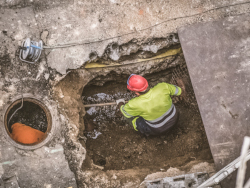Confined Spaces in Sewer Systems
Types of sewer systems include sanitary (domestic sewage), storm (runoff), and combined (domestic sewage and runoff). Sewer systems are extensive and have many different components that are considered confined spaces, including pipelines, manholes, wet wells, dry well vaults, and lift/pump stations. Therefore, employers conducting work in sewer systems will likely have workers who will encounter confined spaces.
Sewer systems also consist of wastewater treatment plants, where confined spaces include digestion and sedimentation tanks, floating covers over tanks, sodium hypochlorite tanks, and wastewater holding tanks, among others. Many of these components may also qualify as permit-required confined spaces.
Hazards Associated with Sewer Systems
Sewer systems can present a host of confined space hazards, including:
- atmospheric hazards (low oxygen, toxic or flammable gases)
- chemicals in piping and from roadway runoff (may harm lungs, skin, or eyes)
- engulfment and drowning
- electrocution (e.g., using electrical equipment in wet working conditions)
- slips, trips, and falls
- falling objects
- high noise levels, low visibility, limits to communication, and long distances to exits
For a complete discussion of confined space safety, be sure to take OSHAcademy Course 713 Confined Space Program.
Knowledge Check Choose the best answer for the question.
5-7. Which of the following is a hazard associated with sewer systems?
You forgot to answer the question!

